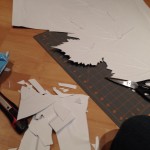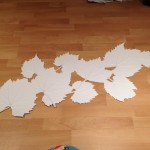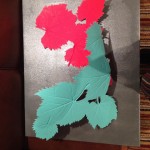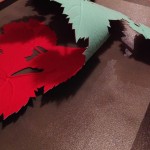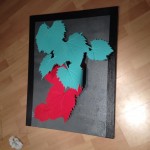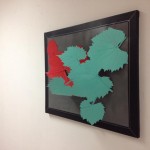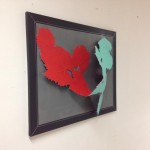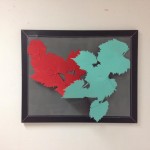This assignment was very flexible, having only one rule: you must include “vacuform” in the project. This is a condensed word we use to refer to “vacuum forming”. If you don’t know what that is and would like an explanation, click here.
After scribbling in my sketchbook for a couple of days with no confidence in my ideas, I discovered a theme. My ideas were either about leaves or electronics. So, I decided to combine the two. The assignment’s purpose was to make a wall piece, so I took it literally and decided to do a television screen; a common item found on a wall. I also decided to approach it with the idea of my piece being 3D, since most movies today are so.
I spent about two hours cutting out my vacuformed leaves to give them a flexibility that would allow me to twist and turn them on a canvas. Even though they already had a relief, I wanted to dramatize the point that they were 3-dimensional. I searched for paint that best resembled the colours found in 3D filming. I used Liquitex’s Professional Spray Paint, colours Cadmium Red Medium Hue and Phthalocyanine Green 7 (Blue Shade), to paint each side of the leaves. I wanted both sides to be different so that the opposite colour would be revealed because of the twist of leaves.
To finish off, I used Beauti-Tone’s Stone Grey Interior/Exterior Paint to transform the canvas into a television screen. Then, I painted the black border to create the screen’s frame and used silver Sharpie to give more details to the border. Using a glue-gun and Gorilla glue, I pasted down the leaves in the position I wanted and left the whole piece to dry. In the end, I was very pleased with the graphics and 3-dimensional feel I gave to it, making it almost a sculpture to walk around, but on the wall.
- Cutting out the vacuformed leaves.
- Product of cutting them out
- Experimenting with the flexibility.
- All the pieces spray painted.
- Discovering the best way to twist it.
- Adding the border.
- Finished Project – right side view
- Finished Project – left side view
- Finished Project – frontal view

